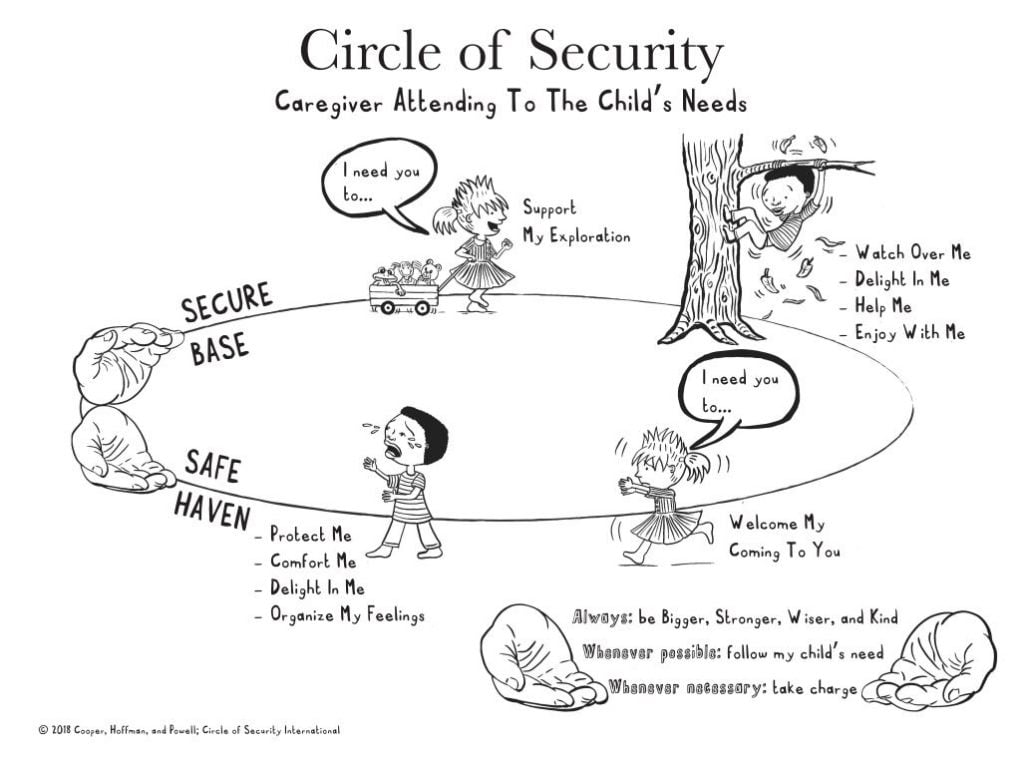Many people hear the term ‘The Circle of Security’, and many people perceive to understand what the Circle of Security really is. However, the key question is.. What does the circle of security look like in practice with young children?
What is the circle of security?
The Circle of Security is a foundational approach to John Bowlby’s attachment theory. Bowlby believes that attachments to other humans are a survival technique, and without those attachments negative impacts occur to children’s long term cognitive, social and emotional development. This is particularly important for young children as the first 1000 days are essential to brain development.
The Circle of Security was developed to guide caregivers in supporting children’s emotional development. Children of all ages have attachment needs, so it is essential that we understand children’s attachment needs.
The Circle of Security is based on the underpinning that children must be supported emotionally at all stages of their emotional journeys.
There are 3 main concepts associated with the Circle of Security
- Going out on the circle: This is when children go out and explore. They are confident for this time and take many risks. During this time caregivers need to be encouraging and praising.
- Coming in on the circle: At times children need to be consoled and need to come back to their caregiver for love and comfort. This time is essentials for caregivers to be welcoming and understanding, supporting children’s emotions rather than dismissing them.
- The safe haven: This defines the caregiver. This is the space where the child can be comforted and feel safe and a sense of belonging. During this space where the caregiver is comforting the child and consoling their every emotion, it is filling the child’s ‘emotional cup’. When the cup is full, the child will go out and play again, demonstrating the top of the circle, and when the cup begins to empty the child comes in on the bottom of the circle
It is essential caregivers are aware of these stages and the importance of being the safe haven for children.

Emotionally Thriving
A caregiver is not just a child parents, or immediate family. Early childhood educators become caregivers too when families leave their children in the trusted care of the educators. At Thrive our educators take this role seriously, and the ensure they enact the Circle of Security approach throughout their practice.
The Circle of Security approach aligns with Thrive’s emotional pillar of learning within our Philosophy. As outlined under Emotionally Thriving, we believe in building authentic trusting relationships with children and families to ensure we have a comprehensive understanding of each child’s emotions, anxieties and needs to be able to nurture their wellbeing and resilience.
The Circle of Security in practice
At Thrive we ensure as many educators as possible are trained in the Circle of Security, as we believe to implement to approach to its integrity requires a comprehensive training session, deconstructing the concepts within the approach and understanding how to contextualise those concepts when working with children.
What does the circle of security look like at Thrive?
When you visit one of our thrive centers you may notice our educators spending extended periods of time sitting with the children. This does not mean our educators are ‘lazy’, but rather it allows children to feel a sense of security and belonging. When adults spend time interacting with children and being available for children at their level it encourages self-esteem and confidence, as children will no longer view the adult as a superior.
You may also hear our educators talking to children frequently about their emotions, consoling them and acknowledging their emotions rather than dismissing them. This too is an important process of the Circle of Security approach. Allowing children to know and understand that what they are feeling is valid and important, supports them in building resilience and ‘filling that emotional cup’ sooner. So, when you see a child feeling sad and you hear our educators acknowledge those feelings, such as “It’s okay to feel bad, its hard missing mummy sometimes” we want you to also understand that this teaching strategy is to support the child.
When children are curious, they ask questions. When children are confident with a sense of belonging, they are curious. Occasionally you may have an interaction with an educator who needs to excuse themselves for a moment to attend to a child who is asking a question. Please do not feel as though our educator is being disrespectful, as attending to children’s needs and their curiosity is important to our Circle of Security approach. Children should not be told to ‘wait’ or ‘hang on’ or ‘come back in a minute’ when they have a question or when an infant is unsettled. In doing so adults cause children to not feel as though they have a safe haven. Although a child may not be unsettled or upset, it does not mean they do not need their emotional cup filled. therefore, when a child is doing a check in with an adult and particularly one of our educators, we understand the importance of attending to the child to help them feel confident again.
